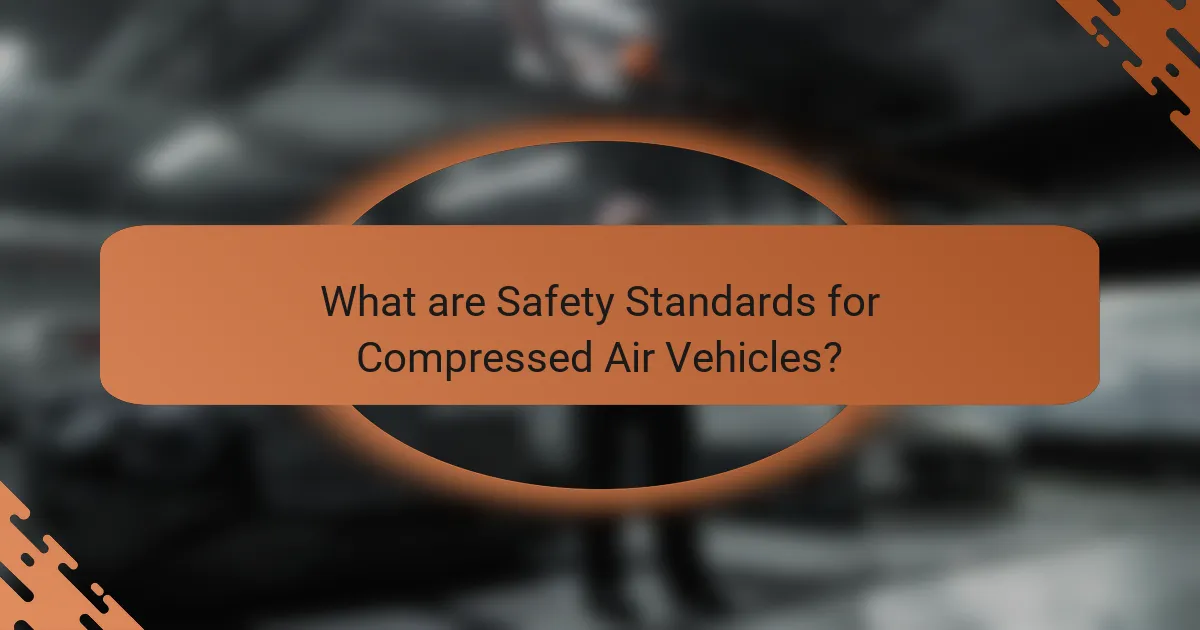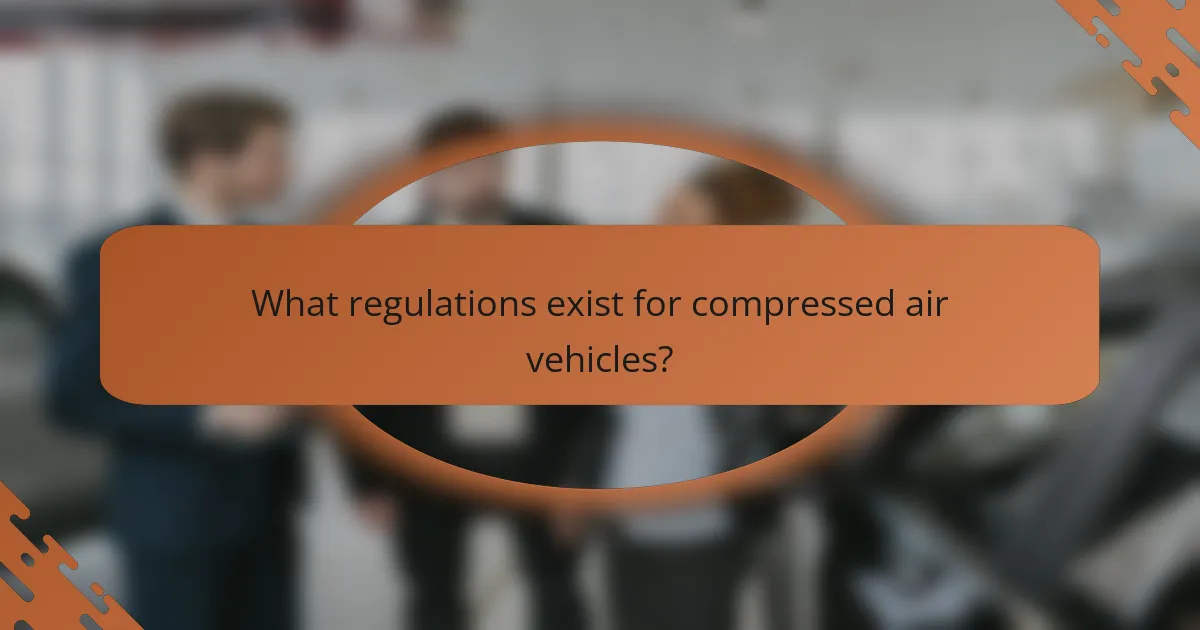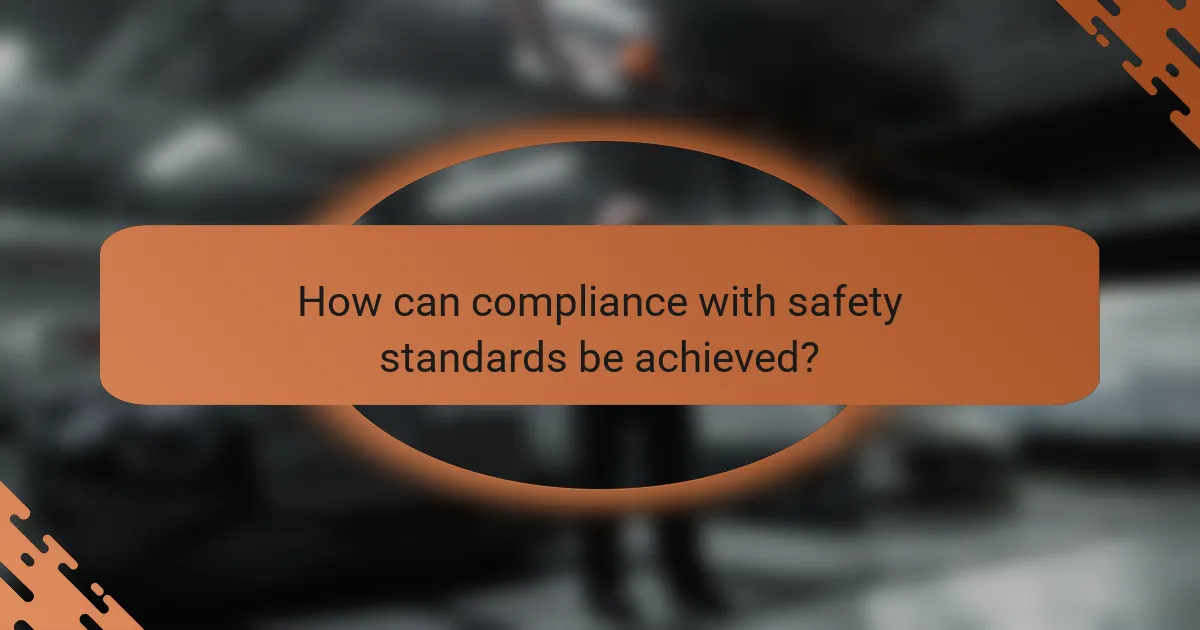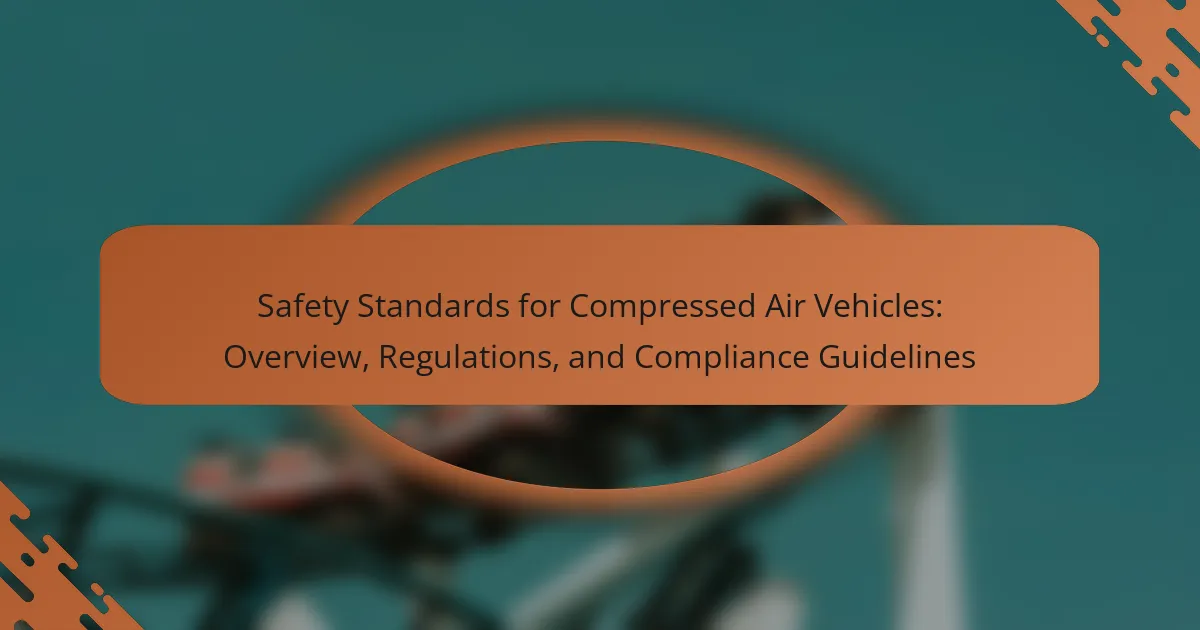Safety standards for compressed air vehicles are critical for ensuring their safe operation and minimizing risks associated with their use. These standards encompass guidelines for pressure vessel integrity, material specifications, and operational protocols, primarily governed by organizations such as the American Society of Mechanical Engineers (ASME) and the National Fire Protection Association (NFPA). Compliance with these regulations is essential for manufacturers and operators, as they ensure that vehicles meet safety requirements before being marketed, adhere to emissions and noise level guidelines, and undergo regular inspections. Implementing a safety management system, conducting risk assessments, and maintaining thorough documentation are key practices for achieving compliance and fostering a culture of safety within organizations involved in the production and operation of compressed air vehicles.

What are Safety Standards for Compressed Air Vehicles?
Safety standards for compressed air vehicles ensure safe operation and minimize risks. These standards include guidelines for pressure vessel integrity, material specifications, and operational protocols. The American Society of Mechanical Engineers (ASME) sets standards for pressure vessels used in these vehicles. Compliance with the National Fire Protection Association (NFPA) regulations is also essential. Testing protocols ensure that vehicles can withstand operational pressures. Regular inspections are mandated to maintain safety compliance. Additionally, manufacturers must adhere to industry best practices for design and maintenance. These standards aim to protect users and the environment from potential hazards.
Why are safety standards important for compressed air vehicles?
Safety standards are crucial for compressed air vehicles to ensure operational safety and reliability. These standards help prevent accidents caused by equipment failure or misuse. Compressed air systems operate under high pressure, which can lead to dangerous situations if not properly managed. Compliance with safety standards reduces the risk of explosions or leaks that could harm users and bystanders. For example, the American National Standards Institute (ANSI) provides guidelines that manufacturers must follow to ensure safe design and operation. Adhering to these standards also promotes industry-wide best practices, enhancing overall public trust in compressed air technology.
What risks are associated with compressed air vehicles?
Compressed air vehicles pose several risks, including potential explosions due to high-pressure systems. The storage tanks can fail if not designed to withstand extreme pressures. Additionally, leaks can occur, leading to loss of efficiency and potential safety hazards. The vehicle’s propulsion system may also be less predictable compared to traditional vehicles. Furthermore, the lack of established safety standards can increase operational risks. According to research by the National Highway Traffic Safety Administration, inadequate testing protocols can result in unforeseen failures. These factors highlight the need for rigorous safety regulations.
How do safety standards mitigate these risks?
Safety standards mitigate risks by establishing guidelines for the design and operation of compressed air vehicles. These standards ensure that vehicles are built with materials that can withstand high pressures. They also require regular inspections and maintenance to identify potential failures before they occur. Compliance with safety standards reduces the likelihood of accidents and injuries. For example, the American National Standards Institute (ANSI) sets regulations that manufacturers must follow. Adhering to these standards has been shown to decrease incidents related to equipment failure. In essence, safety standards create a framework that protects both operators and the public.
What are the key components of safety standards for compressed air vehicles?
Key components of safety standards for compressed air vehicles include pressure vessel integrity, leak detection systems, and operator training requirements. Pressure vessel integrity ensures that tanks can withstand high pressures without failure. Leak detection systems are essential for identifying potential leaks to prevent accidents. Operator training requirements ensure that personnel are knowledgeable about safe handling and operational procedures. These components are critical for minimizing risks associated with compressed air vehicle operations. Compliance with these standards is often mandated by regulatory bodies to enhance safety in the industry.
What regulations govern the design of compressed air vehicles?
Regulations governing the design of compressed air vehicles include safety standards established by organizations such as the Society of Automotive Engineers (SAE) and the International Organization for Standardization (ISO). These regulations focus on aspects like pressure vessel integrity, material specifications, and operational safety. For instance, ISO 11120 specifies the requirements for pressure vessels used in compressed air applications. Additionally, local and national regulations may apply, such as those from the U.S. Department of Transportation (DOT) regarding transportation safety. Compliance with these regulations ensures that compressed air vehicles are designed to operate safely and efficiently.
How do operational guidelines impact safety?
Operational guidelines significantly enhance safety by establishing clear protocols for behavior and procedures. These guidelines ensure that all personnel understand their roles and responsibilities. When operational guidelines are followed, the likelihood of accidents decreases. For instance, specific training requirements reduce human error in high-risk environments. Research shows that organizations with robust operational guidelines experience fewer safety incidents. Compliance with these guidelines fosters a culture of safety and accountability. In the context of compressed air vehicles, adherence to safety standards mitigates risks associated with equipment malfunction. Therefore, operational guidelines are essential for maintaining safety in various operational settings.

What regulations exist for compressed air vehicles?
Regulations for compressed air vehicles primarily focus on safety standards and operational guidelines. These regulations are often governed by national and international bodies. In the United States, the Department of Transportation oversees vehicle safety through the National Highway Traffic Safety Administration. Compressed air vehicles must comply with standards for pressure vessels, which are regulated by the American Society of Mechanical Engineers.
In Europe, the European Union has established directives on vehicle safety that apply to all types of vehicles, including those powered by compressed air. Manufacturers must ensure that their vehicles meet these safety requirements before they can be marketed.
Additionally, specific regulations may vary by region and can include guidelines on emissions, noise levels, and operational safety measures. Compliance with these regulations is essential for the legal operation of compressed air vehicles on public roads.
Which organizations set these regulations?
Regulations for safety standards of compressed air vehicles are set by several organizations. Key organizations include the National Highway Traffic Safety Administration (NHTSA) in the United States. The International Organization for Standardization (ISO) also plays a significant role in establishing global standards. Additionally, the Society of Automotive Engineers (SAE) contributes to technical standards in the automotive industry. These organizations collaborate to ensure compliance and safety in vehicle design and operation. Their regulations are based on extensive research and industry best practices.
What role does the government play in regulating safety standards?
The government plays a crucial role in regulating safety standards. It establishes guidelines to ensure public safety and environmental protection. Regulatory agencies, such as the National Highway Traffic Safety Administration (NHTSA), create and enforce these standards. They conduct research and analysis to identify potential hazards. The government also monitors compliance with safety regulations. It can impose penalties for non-compliance to ensure adherence. Furthermore, it collaborates with industry stakeholders to improve safety measures. Historical data shows that government regulations have significantly reduced accidents and injuries in transportation sectors.
How do international standards influence local regulations?
International standards significantly influence local regulations by providing a framework for safety and compliance. These standards help ensure consistency across different regions. Local regulators often adopt or align their regulations with established international standards. This alignment promotes safety, quality, and interoperability. For example, the International Organization for Standardization (ISO) sets standards that many countries reference in their legislation. Compliance with these standards can enhance market access for local manufacturers. Furthermore, international standards can drive innovation by establishing benchmarks for technology and practices. Overall, the influence of international standards leads to improved safety and efficiency in local regulatory frameworks.
What specific regulations must manufacturers comply with?
Manufacturers of compressed air vehicles must comply with various specific regulations. These include the National Highway Traffic Safety Administration (NHTSA) standards for vehicle safety. Manufacturers must also adhere to Environmental Protection Agency (EPA) emissions regulations. Additionally, they are required to follow the American National Standards Institute (ANSI) standards for safety and performance. Compliance with Underwriters Laboratories (UL) standards for electrical safety is also necessary. Furthermore, manufacturers must meet Occupational Safety and Health Administration (OSHA) regulations regarding workplace safety. These regulations ensure that compressed air vehicles are safe for both consumers and manufacturers.
What are the testing and certification requirements?
Testing and certification requirements for compressed air vehicles include compliance with safety standards set by regulatory bodies. These standards typically require rigorous performance testing to ensure safety and efficiency. Testing must evaluate various aspects such as pressure containment, structural integrity, and operational safety. Certification is generally granted by recognized organizations after successful completion of testing. For example, the Society of Automotive Engineers (SAE) and the American National Standards Institute (ANSI) provide guidelines for these processes. Compliance with these standards is essential for market entry and consumer safety.
How do regulations vary by region or country?
Regulations for compressed air vehicles vary significantly by region or country. For example, the European Union has stringent emissions and safety standards. These standards are designed to ensure environmental protection and public safety. In contrast, regulations in the United States focus more on innovation and market competition. The U.S. allows for more flexibility in compliance, which can lead to varied safety practices. Additionally, countries like Japan have unique certifications for compressed air technology, reflecting local industry needs. Each region’s regulations are influenced by factors such as environmental policies, technological advancements, and public health concerns. This results in a diverse regulatory landscape across different jurisdictions.

How can compliance with safety standards be achieved?
Compliance with safety standards can be achieved through adherence to established regulations and guidelines. Organizations must implement a safety management system that includes risk assessments and safety audits. Regular training for employees on safety protocols is essential. Documentation of safety procedures and incidents helps ensure accountability. Additionally, conducting regular inspections of equipment and vehicles is crucial. Compliance can also be verified through third-party certifications. These measures contribute to a culture of safety within the organization. Studies show that companies with robust safety compliance programs experience fewer accidents and liabilities.
What steps should manufacturers take to ensure compliance?
Manufacturers should implement a comprehensive compliance strategy. First, they must familiarize themselves with relevant safety standards and regulations. This includes understanding both local and international guidelines. Next, manufacturers should conduct regular audits of their processes and products. These audits help identify areas that require improvement to meet compliance. Additionally, training employees on safety practices is crucial. Proper training ensures that everyone understands compliance requirements. Manufacturers should also document all compliance-related activities. This documentation serves as proof during inspections. Finally, manufacturers should engage with regulatory bodies for guidance and updates. This proactive approach helps maintain compliance with evolving standards.
How can companies implement safety management systems?
Companies can implement safety management systems by following a structured approach. First, they should conduct a risk assessment to identify potential hazards. This assessment helps in prioritizing safety measures based on the level of risk. Next, companies need to develop safety policies and procedures that address identified risks. These policies should be communicated to all employees to ensure understanding and compliance.
Training programs are essential for educating employees about safety practices. Regular training sessions reinforce the importance of safety and ensure that employees are aware of their responsibilities. Companies should also establish a reporting system for safety incidents and near misses. This system encourages employees to report hazards without fear of reprisal.
Monitoring and reviewing the safety management system is crucial for continuous improvement. Companies should conduct regular audits to evaluate the effectiveness of their safety measures. Feedback from employees can also provide insights into potential improvements. By following these steps, companies can create a robust safety management system that enhances workplace safety.
What training is necessary for personnel involved in compliance?
Personnel involved in compliance must undergo training in regulatory standards and safety protocols. This training includes understanding relevant laws and regulations specific to compressed air vehicles. It also covers risk assessment and hazard identification related to these vehicles. Personnel should be trained in proper documentation and reporting procedures. Additionally, training in emergency response and safety practices is essential. Regular updates and refresher courses are necessary to keep personnel informed of any regulatory changes. Compliance training is crucial for ensuring safety and adherence to industry standards.
What are the consequences of non-compliance with safety standards?
Non-compliance with safety standards can lead to severe consequences. These include legal penalties such as fines and sanctions imposed by regulatory bodies. Organizations may face increased liability in case of accidents or injuries related to non-compliance. This can result in costly lawsuits and damage claims. Additionally, non-compliance can lead to operational disruptions, including shutdowns or recalls of non-compliant products. Reputational damage may occur, affecting customer trust and market position. According to the Occupational Safety and Health Administration (OSHA), companies that fail to adhere to safety standards can experience a 30% increase in workplace incidents. This data underscores the importance of compliance in maintaining safety and operational integrity.
What legal repercussions can arise from non-compliance?
Non-compliance with safety standards for compressed air vehicles can lead to legal repercussions including fines, penalties, and potential lawsuits. Regulatory bodies enforce compliance through inspections and audits. Failure to meet established standards can result in significant financial liabilities. Companies may face lawsuits from affected parties if safety violations cause harm. Additionally, non-compliance can lead to the revocation of operating licenses. This can severely impact business operations and reputation. Legal repercussions vary based on jurisdiction and the severity of the violation. Enforcement actions are often documented by regulatory agencies to ensure accountability.
How does non-compliance affect company reputation and liability?
Non-compliance negatively impacts company reputation and increases liability. When a company fails to adhere to safety standards, it risks public trust. Customers may perceive non-compliance as negligence or incompetence. This perception can lead to loss of business and negative publicity. Legal repercussions can also arise from non-compliance. Companies may face fines, lawsuits, or regulatory penalties. For instance, a study by the Harvard Business Review indicates that companies with compliance issues often see a 20% drop in customer loyalty. This data underscores the financial implications of damaged reputation due to non-compliance.
What best practices should be followed for safety compliance in compressed air vehicles?
Best practices for safety compliance in compressed air vehicles include regular maintenance checks and adherence to manufacturer guidelines. Operators should inspect pressure vessels for signs of wear or damage. Proper training for personnel on handling compressed air systems is essential. Safety valves must be tested periodically to ensure functionality. Use of personal protective equipment is mandatory during maintenance. Compliance with local and national regulations is crucial. Documentation of safety procedures and incidents should be maintained for accountability. Regular audits can help identify potential safety gaps and improve compliance.
How can regular audits improve safety compliance?
Regular audits improve safety compliance by identifying gaps in safety protocols. They provide systematic evaluations of existing safety measures. Regular assessments help ensure adherence to regulations. They also facilitate the identification of potential hazards. Consistent audits promote a culture of safety awareness among employees. Data from audits can reveal trends in safety incidents. This allows for proactive measures to mitigate risks. Furthermore, audits can enhance accountability by tracking compliance over time.
What role does employee training play in maintaining safety standards?
Employee training is crucial for maintaining safety standards in any workplace, including those involving compressed air vehicles. Proper training equips employees with the knowledge of safety protocols and operational procedures. This knowledge reduces the risk of accidents and injuries. According to the Occupational Safety and Health Administration (OSHA), well-trained employees are 30% less likely to experience workplace accidents. Training also ensures compliance with safety regulations, which can prevent costly fines and legal issues. Regular training updates keep employees informed about new safety practices and technologies. This ongoing education fosters a culture of safety within the organization. Overall, effective employee training directly contributes to a safer working environment.
Safety standards for compressed air vehicles are critical regulations that ensure safe operation and minimize risks associated with high-pressure systems. This article provides an overview of the essential safety standards, including guidelines established by organizations such as the American Society of Mechanical Engineers (ASME) and the National Highway Traffic Safety Administration (NHTSA). Key components of these standards include pressure vessel integrity, leak detection systems, and operator training requirements, all aimed at preventing accidents and protecting users. Additionally, the article explores the importance of compliance, the consequences of non-compliance, and best practices for maintaining safety in the industry.
